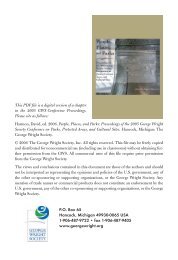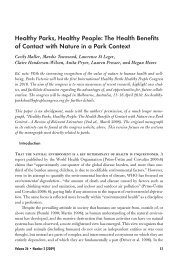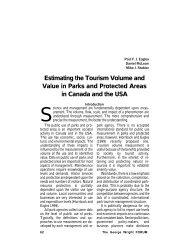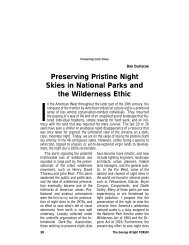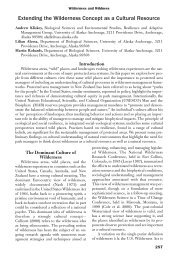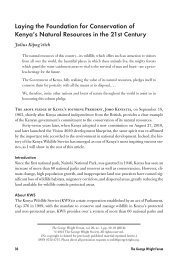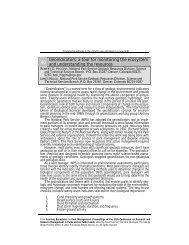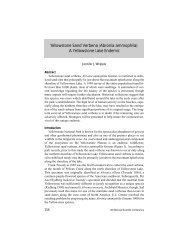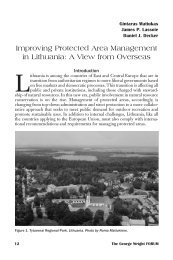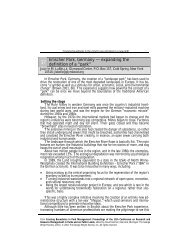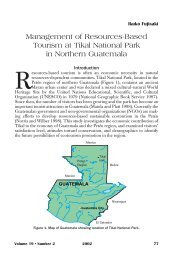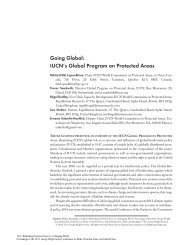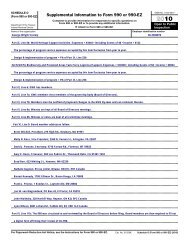Big Egg Marsh Experimental Restoration in Jamaica Bay
Big Egg Marsh Experimental Restoration in Jamaica Bay
Big Egg Marsh Experimental Restoration in Jamaica Bay
You also want an ePaper? Increase the reach of your titles
YUMPU automatically turns print PDFs into web optimized ePapers that Google loves.
Figure 3. By the end of the first grow<strong>in</strong>g season,<br />
<strong>Big</strong> <strong>Egg</strong> <strong>Marsh</strong> rega<strong>in</strong>ed a good carpet of<br />
smooth cordgrass (Spart<strong>in</strong>a alterniflora). The<br />
sandy soil already was accumulat<strong>in</strong>g silt,<br />
algae, and macro<strong>in</strong>vertebrates.<br />
Stakeholder participation<br />
The <strong>Big</strong> <strong>Egg</strong> <strong>Marsh</strong> experimental<br />
restoration is a collaborative<br />
effort that <strong>in</strong>cludes<br />
NPS permanent staff at Gateway<br />
and from the Cooperative<br />
Ecosystem Studies Unit at the<br />
University of Rhode Island.<br />
Other collaborators are AREAC, the Mar<strong>in</strong>e Sciences Institute at Rutgers University,<br />
Department of Oceanography and Mar<strong>in</strong>e Sciences at Dowl<strong>in</strong>g College, U.S. Geological<br />
Survey, Environmental Protection Agency, Natural Resources Conservation Service, New<br />
York State Department of Environmental Conservation, New York City Department of Parks<br />
& Recreation, and three contractors.<br />
NPS’s <strong>Jamaica</strong> <strong>Bay</strong> Institute is located at Floyd Bennett Field, a historic airfield at the<br />
west side of <strong>Jamaica</strong> <strong>Bay</strong>. The <strong>in</strong>stitute’s mission is to lead the way toward improved stewardship<br />
of the <strong>Jamaica</strong> <strong>Bay</strong> ecosystem by creat<strong>in</strong>g a bridge between science and decisionmak<strong>in</strong>g<br />
through research and education on the natural and cultural heritages of <strong>Jamaica</strong> <strong>Bay</strong>.<br />
The <strong>in</strong>stitute endeavors to connect people with the environmental consequences of their<br />
actions. Dur<strong>in</strong>g the past three years, the <strong>Jamaica</strong> <strong>Bay</strong> Institute has dissem<strong>in</strong>ated research<br />
results through publications and workshops, assisted new researchers, and fostered appreciation<br />
and accountability for the <strong>Jamaica</strong> <strong>Bay</strong> ecosystem <strong>in</strong> the urban community. The <strong>in</strong>stitute<br />
is participat<strong>in</strong>g <strong>in</strong> the experimental restoration of <strong>Big</strong> <strong>Egg</strong> <strong>Marsh</strong>.<br />
In 2002–2003, more than 80 volunteers from local community groups, universities, and<br />
government agencies assisted <strong>in</strong> the pretreatment monitor<strong>in</strong>g, site preparation, and plant<strong>in</strong>g<br />
(Figure 4). S<strong>in</strong>ce then, an additional 60-plus volunteers assisted with the ma<strong>in</strong>tenance and<br />
monitor<strong>in</strong>g of the site. Overall, the participants <strong>in</strong> the <strong>Big</strong> <strong>Egg</strong> <strong>Marsh</strong> experimental restoration<br />
number over 200 <strong>in</strong>dividuals, compris<strong>in</strong>g volunteers, student <strong>in</strong>terns, collaborators<br />
from government agencies, contractors, and NPS staff. Many of the volunteers came from<br />
local conservation groups such as the EcoWatchers, the American Littoral Society, the<br />
Audubon Society, and the <strong>Jamaica</strong> <strong>Bay</strong> Task Force. Others came from local bus<strong>in</strong>esses, colleges,<br />
schools, and community organizations. To all these stakeholders, we owe many thanks.<br />
Conclusions<br />
The <strong>Big</strong> <strong>Egg</strong> <strong>Marsh</strong> experimental restoration is technically successful <strong>in</strong>sofar as the sand<br />
is transform<strong>in</strong>g <strong>in</strong>to a silty and organic saltmarsh soil, there is a dense cover of smooth cordgrass,<br />
and an appropriate animal community is becom<strong>in</strong>g established on the treatment site.<br />
Geese graz<strong>in</strong>g and root<strong>in</strong>g <strong>in</strong>creased <strong>in</strong> <strong>in</strong>tensity <strong>in</strong>side the fenced treatment site after the first<br />
128 • People, Places, and Parks



